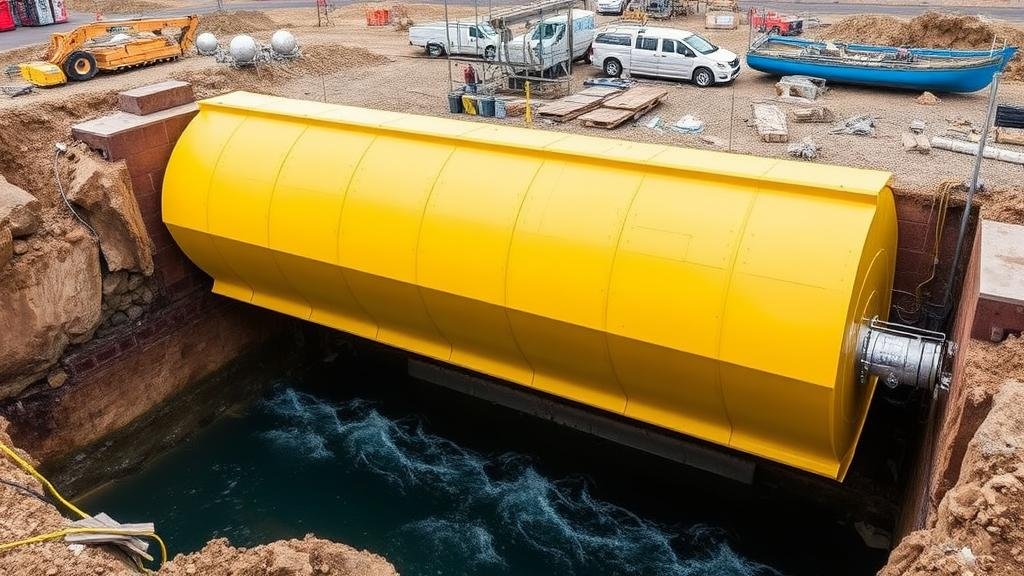Designing and Installing Flood Control Barriers in Deep Shafts
Designing and Installing Flood Control Barriers in Deep Shafts
Flood control barriers are critical infrastructural components used in urban planning, particularly in environments susceptible to water seepage and flooding. In deep shaft applications, the design and installation of these barriers require a careful approach that considers geological conditions, hydrology, and engineering methodologies. This article explores the principles of flood control barrier design and installation in deep shafts, supported by relevant examples and case studies.
Understanding Flood Dynamics in Deep Shafts
Flood dynamics involve the movement and accumulation of water in a particular area. In underground environments such as deep shafts, water can enter through various pathways, including:
- Seepage from groundwater systems.
- Surface runoff during heavy rainfall.
- Pore water pressure from surrounding soil.
According to the U.S. Geological Survey, groundwater can represent up to 20% of total flood volume, especially in deep excavations where water pressure can exert significant forces on structures. For deep shafts, understanding these dynamics is essential for effective barrier design.
Key Design Considerations
Designing flood control barriers in deep shafts involves several key considerations:
- Hydrological Analysis: This is the first step in understanding how water interacts with the site. Hydrological models, such as the Storm Water Management Model (SWMM), can predict the volume of water expected during heavy rainfall events.
- Soil and Rock Properties: Conducting geotechnical investigations is essential to determine the permeability of the surrounding soil and rock. High permeability could indicate a greater need for robust barrier systems.
- Barrier Material Selection: Materials must be chosen based on both structural integrity and waterproofing properties. Common materials include reinforced concrete, steel liners, and synthetic membranes.
Types of Flood Control Barriers
The selection of flood control barriers is dependent on site-specific needs. most common types include:
- Permanent Barriers: Typically constructed of concrete or steel, these barriers are designed to withstand high water levels without being removed.
- Temporary Barriers: Often used during extreme weather events, these can be assembled quickly and include inflatable barriers or portable flood walls.
The choice between permanent and temporary barriers typically hinges upon factors such as budget, anticipated flooding frequency, and space constraints.
Installation Process
The installation of flood control barriers in deep shafts involves several specific steps:
- Site Preparation: This includes clearing the site and ensuring it is free from debris.
- Excavation: Deep shafts may require extensive excavation, which must be executed carefully to prevent water intrusion during the process.
- Barrier Construction: Following proper design specifications, barriers are constructed with a focus on achieving a watertight seal. Reinforcements, such as rebar for concrete structures, enhance durability.
- Quality Assurance: Testing methods, including pressure testing and water-tightness assessments, ensure that the installation meets design requirements.
Case Studies
Real-world examples provide insight into effective flood control barrier design and installation:
- New Orleans, Louisiana: Following Hurricane Katrina, the citys flood defenses were revamped, including deep shaft barriers. The installation of reinforced concrete walls helped protect critical infrastructure from storm surges.
- Tokyo, Japan: The Metropolitan Area Outer Underground Discharge Channel is a large-scale flood control project that utilizes deep shafts. Its design integrates flood barriers to control excess rainwater effectively.
Both examples illustrate the importance of tailored solutions that integrate advanced engineering practices, robust materials, and ongoing maintenance to enhance flood resilience.
Challenges and Solutions
Several challenges can arise during the design and installation of flood control barriers:
- Water Ingress During Installation: In high groundwater conditions, managing water ingress can complicate construction. This can be mitigated by using dewatering techniques, such as well points or deep wells.
- Environmental Concerns: Projects must comply with environmental regulations that protect surrounding ecosystems. Engaging environmental consultants during the planning phase can help address these concerns.
Anticipating and addressing these challenges through strategic planning can increase the success of flood control barrier projects.
Actionable Takeaways
Designing and installing flood control barriers in deep shafts is a multifaceted process requiring expertise in hydrology, geotechnics, and construction methods. Key takeaways include:
- Conduct thorough hydrological and geological analyses prior to design.
- Choose appropriate materials based on site conditions and expected flooding scenarios.
- Plan for challenges such as water ingress and environmental regulations during installation.
- Use case studies for inspiration and lessons learned in similar projects.
By incorporating these strategies, civil engineers and urban planners can enhance flood resilience in urban areas, mitigate risks, and safeguard infrastructure from flooding hazards.



